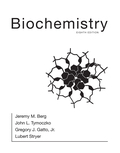
Interpretation:
The reason for the difference in gross value and the net value of ATP formation in glycolysis needs to be explained.
Concept Introduction :
Glycolysis, also termed as the Embden-Meyerhof pathway is an oxidative pathway in which one mole of glucose is converted into two moles of pyruvate. Glycolysis occurs in the cytosol of the cells. It occurs in both aerobic and anaerobic organisms and does not include molecular oxygen.
Explanation of Solution
Glycolysis is divided into two phases, the preparatory phase, and the payoff phase. During the preparatory phase, energy is consumed, but during the payoff phase, energy is produced by the process. The gross energy value is the total amount of energy produced by the glycolysis process. In the payoff phase, four molecules of ATP are produced in the form of energy. The net energy value is the amount of energy actually produced by the glycolysis process. This value takes into account the total energy consumed by the glycolysis process. So, two molecules of ATP are used in the pathway and four ATP molecules are produced, then net ATP production is of two molecules. Due to this, gross and net value for ATP is different in glycolysis.
Want to see more full solutions like this?
Chapter 16 Solutions
EBK BIOCHEMISTRY
- Why bother to eat? What are the three primary uses for cellular energy?arrow_forwardTrue or false? Under anaerobic conditions, the pyruvate dehydrogenase complex is responsible for the irreversible conversion of pyruvate to acetyl CoA.arrow_forwardCalculate the number of ATPs generated by the complete metabolic oxidation of tripalmitin (tripalmitoylglycerol). Hydrolysis of the triacylglycerol occurs at the cell surface. Consider the energy yield from catabolism of glycerol, as well as from the fatty acids. Calculate the ATP yield per carbon atom oxidized, and compare it with the energy yield from glucose.arrow_forward
- True or false? The E2 component of the Pyruvate Dehydrogenase complex binds NAD+ in its active site.arrow_forwardModified true or false. Replace the underlined word if false. Glucagon inhibits beta-oxidation, but stimulates fatty acid biosynthesis.arrow_forwardStructure, function, Oxidative decarboxylation of pyruvate reactions and mechanisms of activity regulation of pyruvatedehydrogenase multi-enzyme complex.arrow_forward
- Entire metabolic pathway of galactosemiaarrow_forwardIsoform of Lactate dehydrogenase LDHarrow_forwardI'm confused about glycolysis and gluconeogenesis. Question: What is the function of glyceraldehyde 3-phosphate dehydrogenase? Is it because of -> The incorporation of a phosphate from ATP and reduction of glyceraldehyde 3-phosphate or ->The incorporation of phosphate from inorganic phosphate and reduction of glyceraldehyde 3-phosphate. or -> The incorporation of phosphate from inorganic phosphate and oxidation of glyceraldehyde 3-phosphatearrow_forward
- Considering the fatty acids: (a) Arachidic acid (C20H40O2); molar mass = 312.5 g/mol) (b) Palmitoleic acid (C16H30O2); molar mass = 256.4 g/mol). How many cycles of β -oxidation are needed for complete oxidation? How many molecules of acetyl CoA are formed from its complete catabolism? How can you calculate the number of molecules (moles) of ATP formed (net) by the complete catabolism of each fatty acid? and the number of moles of ATP formed per gram of each fatty acid metabolized??arrow_forwardCalculate the net ATP yield from the complete processing of a saturated fatty acid containing 17 carbons. Consider the b-oxidation steps, processing of acetyl-CoA through the citric acid cycle, and electron transportarrow_forward9Calculate the total amount of ATP that is produced by the complete oxidation of a 20 carbon even-chain saturated fatty acid. Include the number of each cycle required, describe each stage involved, and list the number of ATP that correspond with each stage.arrow_forward
 BiochemistryBiochemistryISBN:9781305577206Author:Reginald H. Garrett, Charles M. GrishamPublisher:Cengage Learning
BiochemistryBiochemistryISBN:9781305577206Author:Reginald H. Garrett, Charles M. GrishamPublisher:Cengage Learning
